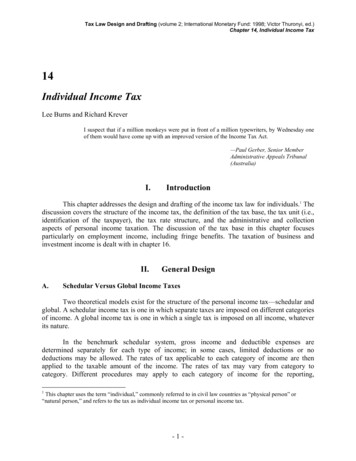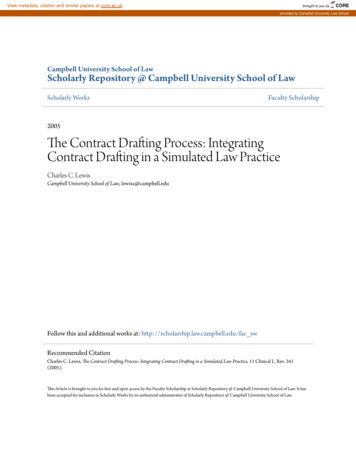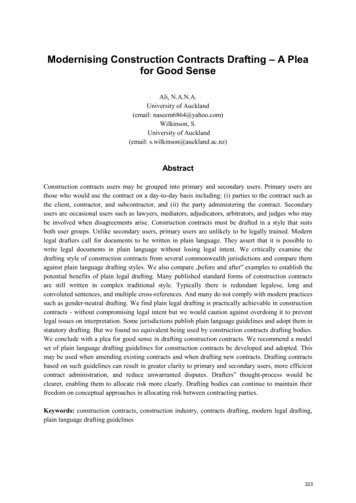
Transcription
Tax Law Design and Drafting (volume 2; International Monetary Fund: 1998; Victor Thuronyi, ed.)Chapter 14, Individual Income Tax14Individual Income TaxLee Burns and Richard KreverI suspect that if a million monkeys were put in front of a million typewriters, by Wednesday oneof them would have come up with an improved version of the Income Tax Act.—Paul Gerber, Senior MemberAdministrative Appeals Tribunal(Australia)I.IntroductionThis chapter addresses the design and drafting of the income tax law for individuals.1 Thediscussion covers the structure of the income tax, the definition of the tax base, the tax unit (i.e.,identification of the taxpayer), the tax rate structure, and the administrative and collectionaspects of personal income taxation. The discussion of the tax base in this chapter focusesparticularly on employment income, including fringe benefits. The taxation of business andinvestment income is dealt with in chapter 16.II.A.General DesignSchedular Versus Global Income TaxesTwo theoretical models exist for the structure of the personal income tax—schedular andglobal. A schedular income tax is one in which separate taxes are imposed on different categoriesof income. A global income tax is one in which a single tax is imposed on all income, whateverits nature.In the benchmark schedular system, gross income and deductible expenses aredetermined separately for each type of income; in some cases, limited deductions or nodeductions may be allowed. The rates of tax applicable to each category of income are thenapplied to the taxable amount of the income. The rates of tax may vary from category tocategory. Different procedures may apply to each category of income for the reporting,1This chapter uses the term “individual,” commonly referred to in civil law countries as “physical person” or“natural person,” and refers to the tax as individual income tax or personal income tax.-1-
Tax Law Design and Drafting (volume 2; International Monetary Fund: 1998; Victor Thuronyi, ed.)Chapter 14, Individual Income Taxassessment, and collection of tax. Some types of income may be taxable only throughwithholding; others may involve the filing of returns. Schedular systems used to be morewidespread; a few countries still have such a system, or one with substantial schedular elements.2In the benchmark global system, there is no matching of particular types of income to theexpenses incurred to derive the income. All income and expenses are considered together toarrive at a single net gain that is subject to tax. Thus, under a pure global system, the category ofincome is irrelevant.Between pure schedular and pure global taxation, there are many possibilities. One ofthese has been called "composite," under which a global-type system is superimposed on a set ofschedular taxes.3 This approach involves combining some or most types of income for thepurpose of imposing a progressive rate surcharge on top of the flat rates commonly imposed onthe schedularized categories of income, as well as for the purpose of providing personal tax relieffor family costs.Many tax policy theoreticians consider the global income tax to be superior to theschedular system. It is commonly suggested that schedular taxation suffers from the followingdisadvantages:(1)The separation of an individual's income into more than one tax regime may makeit difficult or impossible to impose progressive taxation and to provide for personal tax relief (inthe form of exemptions, deductions, or rebates). Progressive taxation is commonly seen as themost effective way of levying taxes on an ability-to-pay basis, and to the extent that ability topay is indicated by an increase in total economic capacity, the tax should be levied on ataxpayer's total income. Under a schedular system, a progressive marginal rate structure may beapplied to some categories of income only, leading to inequities between taxpayers who earndifferent types of income. Similarly, under a schedular system, personal tax relief must be either2According to the latest legislation we could find (see Bibliography of Tax Laws), Burundi, the People's Republicof China, Eritrea, Ethiopia, Lebanon, Romania, Rwanda, Somalia, Sudan, the Republic of Yemen, and theDemocratic Republic of the Congo (formerly Zaire) have a substantially schedular individual income tax, in whichdifferent rate schedules apply to different major categories of income. Although Hungary has a global definition ofincome and a progressive rate schedule for the consolidated tax base (see HUN PIT §§ 4, 30), there are so manyspecial rules and separate rates for different kinds of income that the tax should be considered substantiallyschedular. While the Philippines started out with a global system, a schedular system was adopted in 1981, withwages being taxed separately from other income. See Angel Yoingco, The Dynamics of Income Tax Reform (1985);and National Internal Revenue Code §§ 21, 28, and 29 (J. Nolledo, ed. (1985)). Since then, there has been somemovement back toward a global system, although substantial schedular elements remain. Schedular taxes areimposed on foreign-source income derived by nonresident citizens, and on interest, dividends, and capital gains,while other income is aggregated and subject to tax under a progressive rate schedule. See PHL NIRC § 21. Anumber of other countries treat certain income from capital on a schedular basis, for example, CZE ITA § 36(special rates of tax applicable to interest and dividends); KAZ TC § 13 (interest, dividends, and liquidation gainssubject to final taxes); LSO ITA § 158(2) (final withholding tax on interest). See also infra note 12.3See Sylvain Plasschaert, Schedular, Global and Dualistic Patterns of Income Taxation 17 (1988). Examples ofcomposite systems are those in Chile and Mozambique. The superimposed global tax is typically called a globalcomplementary tax.-2-
Tax Law Design and Drafting (volume 2; International Monetary Fund: 1998; Victor Thuronyi, ed.)Chapter 14, Individual Income Taxapplied wholly against one category of income, such as employment income—in which case therelief may not be fully effective—or divided among various categories of income, whichincreases complexity.(2)The schedular system is potentially more difficult to administer. Scarceadministrative resources may be wasted on classification issues arising at the borders betweenthe various schedules. For example, if income from employment and income from business aretaxed under different schedules, then it becomes necessary to characterize a particular incomeearning activity as being one of employment or business (self-employment). The border betweenan employer-employee and a customer-consultant relationship is difficult to draw.(3)Any differences in the final tax burdens imposed under a schedular system onincome in different categories will be exploited by taxpayers engaging in tax planning andrestructuring to ensure that their income fits within the most advantageous category. Taxplanning activities of this sort not only impose economic dead-weight losses as resources arediverted into unproductive planning activities, but may cause serious economic inefficiency astaxpayers opt for income-earning activities that may be less efficient, but more lightly taxed.While a global income tax may be preferable from a conceptual perspective, the purestform remains a theoretical ideal only. In practice, all global income taxes contain some schedularelements and most existing income tax systems lie on the spectrum between schedular andglobal. While some countries with a global income tax define income without breaking it downinto categories,4 others have a schedular structure to the identification of taxable amounts,whereby such amounts are defined according to categories of income.5 Such a definitionalstructure has two general implications. First, if an item is not included in any of the categories,then it is not included in income. Some countries may have a residual category, but even that isoften not open-ended.6 Second, it will often make a difference into which category an item ofincome falls, because each category has its own rules.7 Even in jurisdictions that do not defineincome by reference to categories, judicial doctrines may classify income into different types.84See COL TC § 26; HUN PIT § 4 (but see supra note 2); RUS IT § 2; USA IRC § 61.5See AUT EStG § 2; BEL CIR § 6; CAN ITA § 3; DEU EStG § 2; FRA CGI § 13; ESP IR § 23; GBR ICTA §§ 15–20; JPN IT § 22; LSO ITA § 17.6See DEU EStG § 22; LSO ITA § 17 (1)(d); SGP ITA § 10(1)(g). See also infra secs. III(A) and VI.7See, e.g., FRA CGI § 13(3).8This approach is common in jurisdictions that have derived their income tax principles from the United Kingdom.For example, AUS ITAA (1997) § 6-1(1) provides that assessable income consists of “ordinary income and statutoryincome.” Statutory income is any amount that is expressly included in assessable income under a provision of thetax law (ITAA (1997) § 6-10(2)). Ordinary income is income classified according to ordinary concepts (ITAA(1997) § 6-5(1)). The definition of income classified according to ordinary concepts has been elaborated by thecourts. An amount derived is ordinary income if it has its source in an earning activity. The earning activitiesidentified by the courts are the employment of one’s labor, the investment of capital, or the application of labor andcapital combined (i.e., the carrying on of a business). This has led to what is, in effect, a judicial categorization ofincome into employment, business, or investment income. The courts have recognized that an amount derived that(continued)-3-
Tax Law Design and Drafting (volume 2; International Monetary Fund: 1998; Victor Thuronyi, ed.)Chapter 14, Individual Income TaxMoreover, whatever the basic definition of income, distinctions are often made in the legislationfor a range of policy and technical reasons. For example, if capital gains are included in the taxbase, they may be treated differently from other types of income.9 Similarly, different rules mayapply to expenses incurred to derive different types of income,10 or discrete sets of rules may beconsidered appropriate for particular types of income.11Finally, the global systems of many countries have become partially schedularized by theuse of final withholding taxes on certain types of income, particularly dividends and interest, andlower tax rates on capital income.12 It has been suggested that in these jurisdictions partialschedularization may actually increase the progressivity of the income tax by eliminatingopportunities for taxpayers to exploit timing differences and other preferential treatment that mayapply to different types of income and expenses.13B.Single or Separate Tax Lawsexhibits some of the essential characteristics of employment, business, or investment income (such as periodicityand anticipation of receipt) may be ordinary income, although it does not have its source in an earning activity.Examples of such amounts are pensions and annuities.9Capital gains may be distinguished because they are subject to preferential rates of tax, are partially exempt fromtax, or are adjusted for inflation, or because restrictions are imposed on the deduction of capital losses.10For example, many jurisdictions distinguish interest outgoings from other expenses for the purpose of imposingquarantining rules. See infra ch. 16. These rules may require further categorization of income types because interestexpense incurred to earn a particular type of income may be deductible only against that type. Another expensequarantining rule found in some jurisdictions is a restriction on the deductibility of employment expenses, whichrequires drawing a distinction between employment and business activity.11An example is farming income, which is taxed on the basis of estimates in a number of countries. See FRA CGI §64; DEU EStG § 13(1); AUT EStG § 21. In such countries, it will be important whether a particular activity isconsidered farming or nonfarming business. Obviously, this is also the case in countries where income fromagriculture is exempt. E.g., GEO TC § 43.12Belgium effectively abolished progressive income tax on dividends and interest in 1985 and replaced it with afinal withholding tax system; see BEL CIR §§ 171, 261, 269. Germany, which had a progressive tax on interest,collected very little on it and introduced a withholding tax in 1994 in order to be able to collect at least somerevenue on interest income; see DEU EStG §§ 43, 43a. Scandinavian countries, led by Sweden, have recentlymoved toward schedularization and final withholding taxes on income from capital. See Leif Mutén, et al., Towardsa Dual Income Tax? (1996). See infra sec. XII, for discussion of final withholding tax on employment income. Seeinfra ch.16 for discussion of final withholding taxes on investment income.13See Mutén, et al., supra note 12. The specific manifestation of this exploitation often is the deduction of interestexpense and other losses against positive capital income. As a result of such deductions, the tax base for capitalincome may be very small without schedularization.-4-
Tax Law Design and Drafting (volume 2; International Monetary Fund: 1998; Victor Thuronyi, ed.)Chapter 14, Individual Income TaxA basic structural question for income tax law is whether to have all income taxes in asingle law or to have two separate laws, one for individuals and one for legal persons (companiesand other taxable entities).14A range of models exists.15 In some countries, company income tax is levied under aseparate tax law from individual income tax, and there is no cross-reference between these lawsfor the determination of the tax base.16 A second model has company income tax levied in a lawseparate from that imposing tax on the income of individuals, but the rules for calculating the taxbase are based on the rules in the individual income tax law,17 or vice versa.18 A third model hasseparate regimes for individuals and companies contained within a single act, with the companytax rules cross-referenced to the individual tax base rules so that the company tax rules in effect"piggyback" on those applicable to individuals.19 A variation of this approach uses the samelegislation and the same basic rules for determining the company and individual tax bases, butincludes supplementary provisions with special rules applicable to companies or individuals.20From a technical perspective, it is equally acceptable to use separate company andindividual income tax laws or a single law, and both alternatives are compatible with eitherclassical or imputation company and shareholder tax systems (these are described in chapter 19).It seems preferable, however, to abstain from separately setting forth the rules for individuals andcompanies, which would lead to duplication, complexity, and the risk of establishing divergentrules. More important than the form of the legislation is its substance. It is important that the taxbase (and rates) of the company tax and the individual tax on business income be similar tosimplify administration and discourage taxpayers from using a possibly less efficient business14Schedular systems may even have separate laws for different categories of income. This was more common in thepast, but currently applies in Romania, for example, although it is proposed to consolidate these laws.15In addition to the basic structural alternatives described, a look at the Bibliography of Tax Laws, infra, shows thatmany countries have, besides the basic individual and corporate income tax laws, other tax laws that contain rulesrelated to income tax. Some of the Scandinavian countries provide examples of this. The resultant structurecontributes to the complexity of the system, although it must be said in fairness that other countries (such as theUnited States) have managed to achieve a comparable if not greater complexity even though they have only one taxlaw.16This is, for example, the case in Latvia, Romania, and Russia. Japan also has separate laws for individuals andcorporations, with independent rules for determining income. In Hungary, the individual income tax law contains itsown rules for measuring business income and expenses; the corporate income tax law refers to the amountdetermined for financial accounting purposes in the case of taxpayers keeping double-entry books. See HUN CTDT§ 6. The tax code of the Kyrgyz Republic contains separate rules for individuals and companies, repeating most ofthe income-determination rules.17See AUT KStG § 7(2); DEU KStG § 8(1); NLD Vpb § 8. Technically, the German company tax is not an incometax, but a tax on profits, the concept of income being reserved for the taxation of individuals.—L.M.18See ESP IRPF § 42.19See FRA CGI § 209.20E.g., AUS ITAA; CAN ITA; COL TC; GBR ICTA; SWE SIL; USA IRC.-5-
Tax Law Design and Drafting (volume 2; International Monetary Fund: 1998; Victor Thuronyi, ed.)Chapter 14, Individual Income Taxform only to secure tax savings arising from differences between the company and individual taxsystems.C.Charging Provision and Basic TerminologyThe personal income tax is, as its name implies, a tax on persons, not on transactions orthings. The charging provision in the income tax law should therefore impose the tax on persons.The tax is not imposed on all persons; rather, it is imposed only on those persons who havetaxable income21 for the relevant tax period.22 Some countries impose the income tax on thetaxable income of persons, rather than on persons having taxable income.23 A charging provisionof this type needs to be supported by a provision that imposes a liability to pay the tax on theperson having the taxable income. The administrative provisions of the legislation will specifythe due date for payment of the tax and include mechanisms for the collection and recovery ofthe tax due.The charging provision sets out four central concepts underpinning the income tax. First,it identifies the person liable for tax, namely, any person who has taxable income for the taxperiod. The issues relating to identifying the taxpayer are discussed in section IX, below. Second,the charging provision imposes the income tax by reference to the tax period. This means thatthe taxable income of any person must be calculated separately for each tax period. Generally,the tax period for the income tax is a specific period of 12 months, commonly the calendar yearor financial year of the relevant country. The periodic nature of the income tax means that it isnecessary to provide accounting rules for allocating income and expenses to particular taxperiods for the purpose of calculating a person's taxable income for the period. These rules arediscussed briefly in section VIII, below, and in more detail in chapter 16.Third, the concept of taxable income defines the tax base. Taxable income is a netconcept determined by reference to the tax period. All income tax systems, whether global orschedular, generally seek to impose taxation on a net amount because this amount properlyreflects a person’s increase in economic capacity for the tax period.24 The taxable income of a21The term “taxable income” is used in this chapter to refer to the amount against which the rates of tax are applied.An alternative term used in some countries is “chargeable income.” See LSO ITA § 13; SGP ITA § 38.22E.g., LSO ITA § 4(1).23E.g., USA IRC §§ 1, 11. Until recently, the income tax law in Australia followed this pattern; however, as part ofthe progressive rewriting of that law, the income tax is now imposed on entities (which is defined to includeindividuals): see AUS ITAA (1997) § 4-1.24There are exceptions to this general rule, the most important being withholding taxes that are imposed on grossreceipts. However, there is often little or no expense involved in deriving some kinds of income commonly subjectto withholding tax, such as interest income. Also, withholding tax rates are commonly lower than ordinary tax rates,the difference being in part attributable to the fact that expenses are not taken into account when withholding taxesare imposed on gross receipts. The application of a lower rate against income that commonly involves fewdeductions means that the withholding tax is effectively a proxy for tax on a net basis.-6-
Tax Law Design and Drafting (volume 2; International Monetary Fund: 1998; Victor Thuronyi, ed.)Chapter 14, Individual Income Taxperson for a tax period is therefore commonly defined as the gross income25 of the person for theperiod less the total deductions allowed to the person for the period. A schedular income tax netsgross income and related deductible expenses on a schedule-by-schedule basis, while a globalincome tax nets gross income against total deductible expenses. The specification of the tax baseis discussed in sections III–VII, below. Fourth, the charging provision should provide for thecalculation of the amount of tax payable. In the ordinary case, this involves applying the relevanttax rates to the taxable income of the taxpayer and then subtracting any tax offsets that may beavailable to the taxpayer. Tax offsets are reductions in the amount of tax otherwise payable.26They are allowed primarily to reflect tax already paid through a special collection regime or as aconcession to achieve certain social or economic objectives. Design issues relevant to tax ratesare discussed in section X, below, and tax offsets are discussed in section XI, below.By clearly specifying the central concepts, the charging provision will ensure that there isconsistency in the use of terminology, thereby providing a coherent structure for the substantiveprovisions of the legislation. It is preferable that the charging provision be included at thecommencement of the legislation so that the substantive provisions can then be developed as anelaboration of the central concepts specified in the provision. The importance of consistencycannot be emphasized too strongly. At best, failure to provide a coherent structure will lead to aconfused application of the tax law; at worst, it will make the law unworkable. For example, itmust be clear that charging provisions apply to taxable income and not to gross income.27Similarly, it must be made clear whether supplementary definition provisions include amounts ingross income or in taxable income.III.Taxable IncomeThe concept of taxable income effectively defines the income tax base. It was statedabove that the taxable income of a person for a tax period is commonly defined as the grossincome of the person for the period less the total deductions allowed to the person for theperiod.28 The gross income of a person for a tax period is the total of amounts derived29 by theperson during the period that are subject to tax. The gross income of a person, therefore, will notinclude amounts that are exempt from tax. The total deductions of a person for a tax period are25Also sometimes called "assessable income." See AUS ITAA (1997) § 4-15.26Tax offsets are known by a variety of technical labels, including tax credits, tax rebates, and deductions of tax. Fora discussion of the terminology used in various countries to describe tax offsets, see infra note 205.27Unless, of course, it is gross income on which the tax is levied as with withholding taxes. It must be clearly statedwhen tax is imposed on taxable income and when it is imposed on gross income.28E.g., AUS ITAA (1997) § 4-15 (1), (“taxable income assessable income-deductions”); CAN ITA § 2(2) (taxableincome defined as income plus certain additions and minus certain deductions); USA IRC § 63(a) (taxable incomedefined as gross income minus deductions).29The word “derived” is used in this chapter to refer to the allocation of an amount to a particular tax periodaccording to the application of tax accounting rules. See infra sec. VIII.-7-
Tax Law Design and Drafting (volume 2; International Monetary Fund: 1998; Victor Thuronyi, ed.)Chapter 14, Individual Income Taxthe total of expenses incurred by the person during the period in deriving amounts subject to taxplus any capital allowances and other amounts allowed as a deduction on a concessional basis(e.g., charitable donations). Consequently, there are three key elements in the definition of thetax base: first, the inclusion of amounts in gross income; second, the identification of amountsthat are exempt income; and third, the allowance of amounts as deductions.The definition of key concepts related to the determination of taxable income, drawing oncommonly accepted understandings and notions in the jurisdiction, will depend in part on thestructure of the income tax system to be adopted and in part on existing structures and concepts.Even when general definitions are used, they are inevitably supplemented by specific definitions,inclusion rules, exclusion rules, rules allowing deductions, and rules denying certain deductions.Thus, any consideration of general definitions must be made in the context of plans for specificrules.A.Gross IncomeSupplementary definition and inclusion provisions applying to the determination of grossincome have proved increasingly important for the implementation of global tax systems. Thereare three reasons for this. The first is the circular definition of income that characterizes manyglobal systems. As stated above, taxable income is normally defined as gross income lessallowable deductions. But the definition of gross income may provide little guidance to theincome concept, often including the term that it purports to define.30 Second, and related to thefirst point, supplementary definition and inclusion provisions may be needed to overcome theotherwise restrictive concept of income that would be applied by courts, particularly inCommonwealth or former Commonwealth countries, where courts rely on U.K. judicialdoctrines.31 Third, supplementary definition and inclusion provisions may be required in responseto the growing complexity and variation of legal forms and transactions.32Consequently, even under a global income tax, the inclusion of amounts in gross incomewill often be specified by reference to particular categories of income. For this purpose, incomeis commonly divided into employment, business, and investment income. There are oftensupplementary definitions of each category of income and, in the case of investment income,definitions of amounts included in investment income (e.g. dividends, interest, rent, androyalties).30E.g., AUS ITAA (1997) § 6-1(1) (“assessable income consists of ordinary income and statutory income"); CANITA § 3 (income defined as "the total of all amounts each of which is the taxpayer's income"); EST ITL § 9 (“theincome of a resident taxpayer is all income derived.”); USA IRC § 61(a) (gross income defined as "all incomefrom whatever source derived").31See supra note 8.32For example, special definitional provisions may be needed to define as interest income certain types of gainrealized on financial transactions. See infra ch.16.-8-
Tax Law Design and Drafting (volume 2; International Monetary Fund: 1998; Victor Thuronyi, ed.)Chapter 14, Individual Income TaxHowever, not all amounts derived by a taxpayer will fit neatly into one of thesecategories.33 An issue arises, therefore, as to the specification of other amounts to be included ingross income. This is commonly done by separately listing out those amounts. As stated above,such a definitional structure means that any amount that does not come within one of the listedinclusions will not be included in gross income. This may be overcome by including a residualcategory of income. The residual category may itself be a separate category.34 Alternatively, thelist of amounts included in gross income may be expressed to be inclusive only so that a generalformula may apply for including other amounts in gross income.35 Regardless of how the residualcategory is identified, it is important that there be some certainty in the scope of its operation.Sometimes the word “income” is used to define the residual category.36 In the absence of adefinition of income,37 such an approach can lead to uncertainty where the word is used in ajurisdiction in which it has no established meaning.38 On the other hand, where it does have anestablished meaning, care must be taken to ensure that the use of the word income does notunduly restrict the intended scope of the tax base. A preferable approach may be to define theresidual category broadly so that it covers all gains of whatever nature and rely on the definitionof exempt income to limit its scope.39The discussion of the tax base below and in chapter 16 follows an approach that dividesincome into four broad categories: employment, business, and investment income, andmiscellaneous receipts.B.Exempt Income33See infra sec. VI for examples of amounts that may fall outside a classification of income into employment,business, and investment income.34E.g., LSO ITA § 17(1)(d); SGP ITA § 10(1)(g).35E.g., EST ITL § 9(1) (“income of a resident taxpayer is all income derived by him/her from all sources of incomeduring the period of taxation, including” seven specified categories of income. The inclusive nature of the provisionmeans that any other amount derived by a resident taxpayer that is “income” is taxed); IDN LCIT Art 4(1) (“the TaxObject is income, meaning any increase in economic prosperity received or accrued by a Taxpayer.that may beused for consumption or to increase the wealth of such Taxpayer, in whatever name and form, including” 11specified categories of income. Again, the inclusive nature of the provision means that any other amount that is“income” is taxed). “Inclusive” is used here to refer to a definition that takes the form of including specified items ina general concept, as opposed to offering an exhaustive d
Tax Law Design and Drafting (volume 2; International Monetary Fund: 1998; Victor Thuronyi, ed.) Chapter 14, Individual Income Tax - 1 - 14 Individual Income Tax . elements and most existing income tax systems lie on the spectrum between schedular and global. While some countries with a global income tax define income without breaking it down










